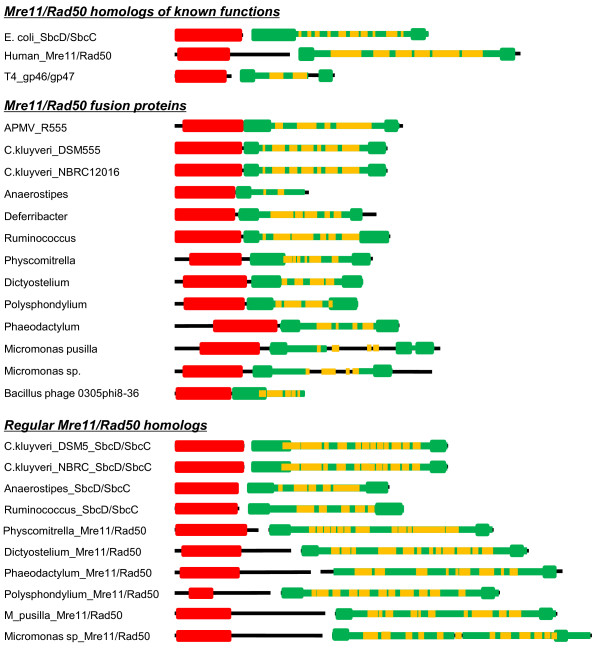Figure 1.
Domain organization of Mre11/Rad50 (SbcD/SbcC) homologs. Sequence regions corresponding to nuclease (SbcD/COG0420) and ATPase (SbcC/COG0419) are highlighted by red and green lines, respectively. Within SbcC regions, ATP-binding domains (cd03279) are indicated by thicker green lines, and the predicted coiled-coil regions are indicated by orange line. This diagram is approximately drawn to scale. Database entries for sequences are as follows: Ecoli_SbcD/SbcC, Escherichia coli K12 (NP_414932/NP_414931); Human_Mre11/Rad50, Homo sapiens (NP_013951/NP_014149); T4_gp46/gp47, E. coli phage T4 (NP_049672/NP_049669); C.kluyveri_DSM_SbcD/SbcC, Clostridium kluyveri DSM 555 (YP_001393540/YP_001393539); C.kluyveri_NBRC_SbcD/SbcC, Clostridium kluyveri NBRC12016 (B9DY24_CLOK1/B9DY23_CLOK1); Anaerostipes_SbcD/SbcC, Anaerostipes caccae DSM 14662 (ZP_02418331/ZP_02418330); Ruminococcus_SbcD/SbcC, Ruminococcus sp. 5_1_39BFAA (ZP_04855442/ZP_04855441); Physcomitrella_Mre11/Rad50, Physcomitrella patens subsp. patens. (XP_001755538/Pp1s51_220V6); Dictyostelium_Mre11/Rad50, Dictyostelium discoideum (XP_629462/XP_628997); Phaeodactylum_Mre11/Rad50, Phaeodactylum tricornutum CCAP 1055/1 (XP_002181412/XP_002179845); Polysphondylium_ Mre11/Rad50, Polysphondylium pallidum PN500 (EFA85561/EFA85515); M_pusilla_Mre11/Rad50, Micromonas pusilla CCMP1545 (XP_003063605/XP_003055898); Micromonas sp_Mre11/Rad50, Micromonas sp. RCC299 (XP_002504614/XP_002507736).

